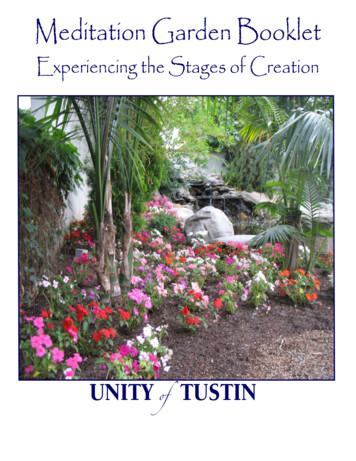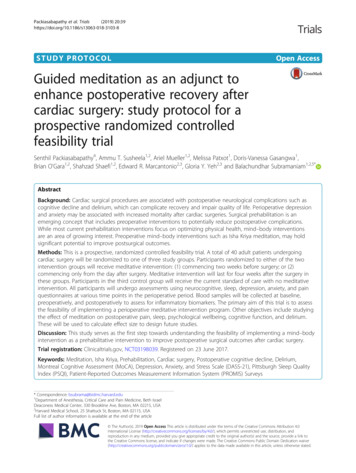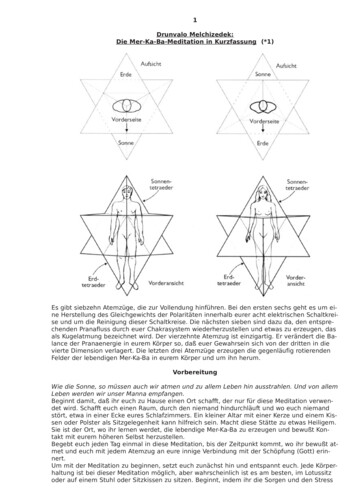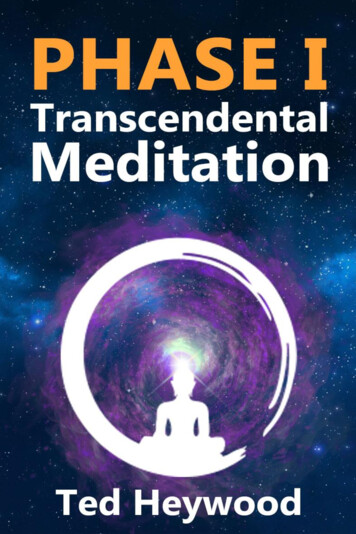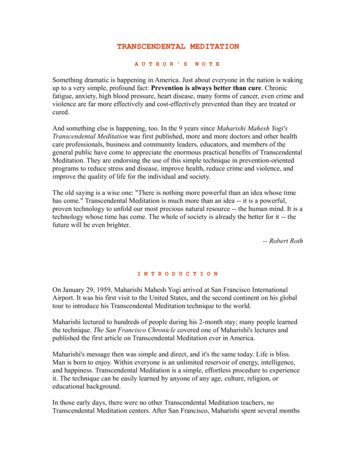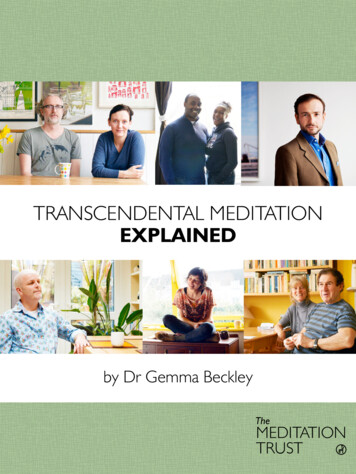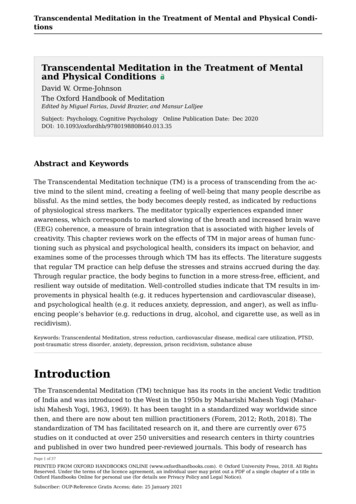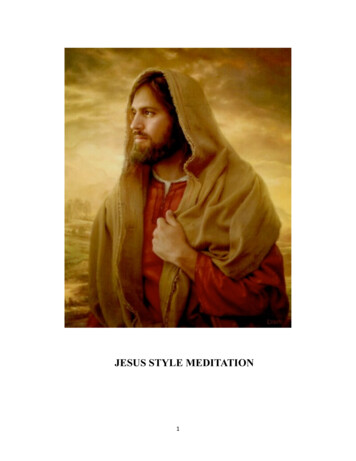
Transcription
JESUS STYLE MEDITATION1
Meditation in The Urantia Book(Jesus-style meditation)by Peter Holley[All bold words throughout indicate emphasis added by the author.]Words Change Their Meaning1The URANTIA Book tells us that Jesus meditated – a lot! What it doesn’t sayis that the word “meditation” has evolved away from its original meaning duringthe years following the revelation’s final inditing in the mid 1930s. Such evolutionof words was, of course, anticipated by the revelators, who tell us that theexpression of religion “must be restated every time the dictionary of humanlanguage is revised” (1). Likewise the meaning of each affected teaching needs tobe renewed when necessary.The problem with changed words is that they can give us an altered picture ifwe aren’t careful. The fact that Jesus used and taught meditation as a means tocommunicate with one’s Thought Adjuster makes it vitally important for us tounderstand what is meant, if as The URANTIA Book states on the last page, the“great challenge for modern man is to achieve better communication with thedivine Monitor that dwells within the human mind.”A dictionary contemporary with the reception of the finalized Urantia Papers(as later originally published in The URANTIA Book) provides the followingdefinition of the word “meditation”:2
“ close or continued thought, the turning or revolving of a subject in themind, serious contemplation; mental reflection; often specifically, thought devotedto religious subjects.” (2)The type of “meditation” often associated with Eastern religions whichrequires an altered state of consciousness had not yet at that time migrated into thedictionary. It became a secondary definition of “meditation” sometime after YogiParamhansa Yogananda came to the West and brought about what has been called areligious revolution with the publication of his book Autobiography of a Yogi in1946. Yet a look at a 1955 desk dictionary shows that the more intellectuallypassive type of meditation had not even appeared by The URANTIA Book’spublication date. Neither is it included in my 1982 “College” dictionary. Somemodern dictionaries, however, now place it as the preferred definition. Thefollowing definition of the intransitive use of the verb is from an online dictionary(3):meditate:1.A. Buddhism & Hinduism. To train, calm, or empty the mind, often byachieving an altered state, as by focusing on a single object.B. To engage in devotional contemplation, especially prayer.2. To think or reflect, especially in a calm and deliberate manner.This is not to say, however, that the Buddhism and Hinduism style ofmeditation was unknown in the middle thirties in the West, or that the word“meditation” was never used to denote it. It was, but it appears to have neededqualification. Apparently the Buddhism and Hinduism type is what the revelatorsmeant when they referred to “mystic meditation” (see also “mystic trances,”“mystic communications,” “mystic experiences,” “mystic phenomena,” “mystic3
communion,” “mystic status,” and “mystical state”). The root of “mystic” is aGreek term meaning “belonging to secret rites” or “priest of mysteries,” and theword itself in the middle of the 1930s referred to things which were secret orobscure. The fact is that Buddhist and Hindu meditators at that time still kept theirtraditional techniques as highly guarded secrets, passing them on only to followerswhom they considered to be qualified to receive them. And their meditativetechniques seemed even more “mystical” because they revolved around alteredconsciousness and brought about – to the Western way of thinking – extraordinaryexperiences. Some few Europeans living in the East had, however, submitted toyogis or to Buddhist masters and applied themselves to their esoteric teachings,and then, later, brought the practices back home with them.One instance of such early, non-dictionary-defined use is found in a thencontemporary publication that is believed to have furnished the source for much ofthe Rodan material in The URANTIA Book (4). This example which is found in thebook, Issues of Life, by Henry Nelson Wieman (5), demonstrates a need for theword “meditation” to be modified in order to indicate something akin to theBuddhism- and Hinduism-style technique. Wieman speaks of “a kind ofworshipful, meditative waiting, in which one quietly hearkens until the call of theworld and the deepest desire of his own heart merge into a single demand. Waitingbefore the Highest,” he writes, “fosters inarticulate aspiration.” (6) Rather thansimply calling it “meditation,” as many might today, Wieman had to coin the term“inarticulate aspiration” and link it to “a kind of worshipful, meditative waiting.”But what is most illustrative by this example, however, is the fact that therevelators took Wieman’s passive “kind of worshipful, meditative waiting” andturned it into the dynamically active, reflective type of meditation in the abovedefinitions, that is, the style of meditation that Jesus used and taught. Themidwayer author of Part IV compared such deep-thinking meditators with “high4
climbing souls” who reach a “mountaintop of intellectual thought” where they can“attain consciousness of the higher currents of spirit concept and celestialcommunication.” (7). Elsewhere The URANTIA Book laments, however, that it is“sad to record that so few persons on Urantia take delight in cultivating thesequalities of courageous and independent cosmic thinking.” (8)RodanRodan gives us what is perhaps the best view in The URANTIA Book of thetype of meditation that Jesus both taught and practiced himself. Rodan had“become a disciple of Jesus through the teaching of one of Abner’s associates whohad conducted a mission at Alexandria” (9). And Abner, of all of Jesus’ disciples,apparently had the best grasp on Jesus’ teachings. At least we are told that “duringthe later years of Abner and for some time thereafter, the believers at Philadelphiaheld more strictly to the religion of Jesus, as he lived and taught, than any othergroup on earth.” (10) In any event the Rodan material certainly was not placed inThe URANTIA Book to mislead us.Rodan spoke of what Jesus “so consistently practices, and which he has sofaithfully taught . . . the isolation of worshipful meditation . . . this habit of Jesus’going off so frequently by himself to commune with the Father in heaven.” Jesuswas, Rodan said, even as he spoke “out in the hills taking in power. . . .” (11)Rodan went on to say that the “secret of all this problem is wrapped up inspiritual communion, in worship. From the human standpoint it is a question ofcombined meditation and relaxation. Meditation makes the contact of mind withspirit; relaxation determines the capacity for spiritual receptivity. And thisinterchange of strength for weakness, courage for fear, the will of God for the mindof self, constitutes worship.” (12) He observed that on “every mountaintop ofintellectual thought are to be found relaxation for the mind, strength for the soul,5
and communion for the spirit.” And he indicated how the lower, egoistic thinking isto be overcome by higher thoughts:“From such vantage points of high living, man is able to transcend the materialirritations of the lower levels of thinking – worry, jealousy, envy, revenge, and thepride of immature personality. These high-climbing souls deliver themselves froma multitude of the crosscurrent conflicts of the trifles of living, thus becoming freeto attain consciousness of the higher currents of spirit concept and celestialcommunication.” (13)The Greek philosopher-turned-disciple added:“When these experiences are frequently repeated, they crystallize into habits,strength-giving and worshipful habits, and such habits eventually formulatethemselves into a spiritual character, and such a character is finally recognized byone’s fellows as a mature personality. These practices are difficult and timeconsuming at first, but when they become habitual, they are at once restful andtimesaving.” (14)Notice that for Rodan the relaxation associated with Jesus’ dynamic, thinkingtype of meditation is a result of having reached the “mountaintop of intellectualthought” and “spiritual communion” rather than being part of the means to attain it– that is, a more or less stand-alone part of the technique – as it is in Hinduism andBuddhism (and in auto-hypnosis).Rodan’s most profound statement is, “Meditation makes the contact of mindwith spirit.” In other words, spirit is contacted by the actively thinking mind. Andthis is entirely consistent with what we are taught elsewhere in The URANTIABook about the nature of the Thought Adjusters vis a vis the mortal mind.Thought Adjuster6
We are told quite clearly and in a number of ways that the Thought Adjustersdwell and interact within “the thinking centers of the individual’s mind” (15):“If one is disposed to recognize a theoretical subconscious mind as a practicalworking hypothesis in the otherwise unified intellectual life, then, to be consistent,one should postulate a similar and corresponding realm of ascending intellectualactivity as the superconscious level, the zone of immediate contact with theindwelling spirit entity, the Thought Adjuster.”(16)“Human consciousness rests gently upon the electrochemical mechanismbelow and delicately touches the spirit-morontia energy system above. Of neitherof these two systems is the human being ever completely conscious in his mortallife; therefore must he work in mind, of which he is conscious.”(17)Notice how closely this idea of “ascending intellectual activity” parallelsRodan’s image of meditation being intellectual mountain climbing. Notice also thatit is not the lower area of consciousness which is involved, but the upper “spiritmorontia energy system.”“The chief difficulty you experience in contacting with your Adjusters consistsin [your] very inherent material nature. So few mortals are real thinkers; you donot spiritually develop and discipline your minds to the point of favorable liaisonwith the divine Adjusters. The ear of the human mind is almost deaf to the spiritualpleas which the Adjuster translates from the manifold messages of the universalbroadcasts of love proceeding from the Father of mercies. The Adjuster finds italmost impossible to register these inspiring spirit leadings in an animal mind socompletely dominated by the chemical and electrical forces inherent in yourphysical natures”(18)Here the assumption is that thinking both contacts and “hears” the ThoughtAdjuster, since nothing is being said about passive “listening.” The Thought7
Adjusters do not speak to our minds but must use our minds to speak for them.They do this with our own thinking processes:“The Thought Adjuster has no special mechanism through which to gain selfexpression; there is no mystic religious faculty for the reception or expression ofreligious emotions. These experiences are made available through the naturallyordained mechanism of mortal mind. And therein lies one explanation of theAdjuster’s difficulty in engaging in direct communication with the material mindof its constant indwelling.“The divine spirit makes contact with mortal man, not by feelings or emotions,but in the realm of the highest and most spiritualized thinking.” (19)[The Thought Adjuster] ‘‘is the higher and truly internal spiritual stimulus ofthought . . . .’’ (20)“The Adjuster is not trying to control your thinking, as such, but rather tospiritualize it, to eternalize it. Neither angels nor Adjusters are devoted directly toinfluencing human thought; that is your exclusive personality prerogative. TheAdjusters are dedicated to improving, modifying, adjusting, and co-ordinating yourthinking processes . . . .” (21)The divine indwellers adjust our thinking until it speaks for them, until thecontent of our thoughts coincides with higher truth and their translations of theuniversal broadcasts from the Paradise Father. What we experience in theperfecting of Jesus-style meditation is at the same time their thinking and our own!Also, Rodan likewise spoke of the need for the mental discipline found in thefrequent repetition of the practice of worshipful, dynamic-thinking-coupled-withrelaxation, that is, Jesus-style meditation, in order to develop the mind for spiritualcommunication.8
It is plain to see that in Jesus-style meditation the “worry, jealousy, envy,revenge, and the pride of immature personality” of which Rodan spoke are to be tobe harnessed and used by us rather than being emptied from the mind at thestart as both the yogis and the Buddhists do. It is we who must take our thoughts –as we find them – and aim them Godward. Jesus said:“Be not constantly overanxious about your common needs. Be notapprehensive concerning the problems of your earthly existence, but in all thesethings by prayer and supplication, with the spirit of sincere thanksgiving, let yourneeds be spread out before your Father who is in heaven.” (22)At the same time Jesus exhorted “his believers to employ prayer as a means ofleading up through thanksgiving to true worship” (23). And Rodan speaking ofthese same things wrapped up meditation, relaxation, and spiritual communion intothe same ball of wax as constituting “worship” or “worshipful meditation.” Sofrom this we see that there is really only a difference in degree between all of thisGod-directed thought: prayer, cosmic thinking, thanksgiving, meditation, andworship. They are like different members of a family rather than different species.For instance, in some of its aspects meditation differs little from prayer, and inothers it is the same as worship. It may, likewise, be productive of greatoutpourings of thanksgiving.Prayer, The URANTIA Book reveals, is the only “technique whereby everyman, regardless of all other mortal accomplishments, can so effectively andimmediately approach the threshold of that realm wherein he can communicatewith his Maker, where the creature contacts with the reality of the Creator, with theindwelling Thought Adjuster.” (24) Also, “Prayer will lead the mortals of earth upto the communion of true worship.” (25) But “meditation makes the contact ofmind with spirit,” and the “moment the element of self-interest intrudes uponworship, that instant devotion translates from worship to prayer” (26) – the same is9
no doubt true concerning the higher and lower aspects of Jesus-style meditation. Itslower aspect is commonly a quest for knowledge and understanding of a subject orproblem, a factual elucidation. The higher aspect – transcendent, worshipfulmeditation – is a type of self-forgetful cosmic thinking, and it is here thatknowledge and understanding, or spiritual elucidation, is likely to be found.“Thinking surrenders to wisdom, and wisdom is lost in enlightened andreflective worship.” (27) – “wisdom [is] meditative and experientialthinking” (28); “worship is self-forgetting – superthinking.” (29)Or restated:“Ordinary thinking ascends to meditative and experiential thinking, and it, inturn, transcends into enlightened and reflective worship.”And again:“Why do you not aid the Adjuster in the task of showing you the spiritualcounterpart of all these strenuous material efforts? Why do you not allow theAdjuster to strengthen you with the spiritual truths of cosmic power while youwrestle with the temporal difficulties of creature existence? Why do you notencourage the heavenly helper to cheer you with the clear vision of the eternaloutlook of universal life as you gaze in perplexity at the problems of the passinghour? Why do you refuse to be enlightened and inspired by the universe viewpointwhile you toil amidst the handicaps of time and flounder in the maze ofuncertainties which beset your mortal life journey? Why not allow the Adjuster tospiritualize your thinking, even though your feet must tread the material paths ofearthly endeavor?” (30)It was in this sense that Jesus told Peter:“Let experience teach you the value of meditation and the power of intelligentreflection.” (31).10
Also Jesus-style spiritual meditation is an essential factor of spiritual growth:“Habits which favor religious growth embrace cultivated sensitivity to divinevalues, recognition of religious living in others, reflective meditation on cosmicmeanings, worshipful problem solving, sharing one’s spiritual life with one’sfellows, avoidance of selfishness, refusal to presume on divine mercy, living as inthe presence of God” (32)Jesus MeditatingIn almost every instance of examples in The URANTIA Book wherein Jesusmeditated, the context clearly shows that he was engaged in thought (see listbelow). In those few in which it is not abundantly apparent it may be assumed thathe was since nowhere is any contrary notion maintained. In fact in The URANTIABook the meditative doctrine of “thinking nothing” (along with “seeing” and“doing” nothing), which was derived from the teaching by Lao T’su on“nonresistance and the distinction which he made between action andcoercion” (and which can still be found in the teachings of Buddhism) is called“perverted” by the revelators (33). And cultivation of the “mystical state” (or“trancelike state of visionary consciousness”) which is described of consisting inpart of a “comparatively passive intellect” – we are warned – should be in allcircumstances shunned as a means of religious experience because it “gravitatesconsciousness toward the subconscious rather than in the direction of the zone ofspiritual contact” (34), that is, toward the lower, animal level rather than the upper,morontia-spiritual level of consciousness. Whether or not this warning speaksdirectly to the meditation practices of Hindus and Buddhists is problematical (butsee below). In the final analysis it is up to the devotees of the more passive intellectstyles of meditation to make such discernments for themselves. Personally, as afollower of Jesus, I prefer to align my meditation practices with those of myMaster and Elder Brother, Jesus of Nazareth:11
1. As early as his eleventh year Jesus engaged in “profound meditation andserious contemplation.” The content of this mental discipline, we are told, was his“thinking about how he was to carry out his obligations to his family and at thesame time be obedient to the call of his mission to the world.” (35)2. When Jesus was thirteen he visited the temple in Jerusalem for the firsttime. When he first saw the throngs gathered together for Passover, he “meditateddeeply on how these Jews had assembled here from the uttermost parts of theknown world.” (36) During this visit his family stayed at Bethany and he spent“much of the time alone in the garden meditating.” (37) And we are told that atleast some of this meditation in the garden “was concerned with thecontemplation of weighty problems.” (38)3. In Jesus fourteenth year “he made frequent trips to the top of the hill to thenorthwest of Nazareth for prayer and meditation.” During this time he “wouldgaze upon Megiddo and recall the story (thought) of the Egyptian army winningits first great victory in Asia; and how, later on, another such army defeated theJudean king Josiah. Not far away he could look upon Taanach, where Deborah andBarak defeated Sisera. In the distance he could view the hills of Dothan, where hehad been taught Joseph’s brethren sold him into Egyptian slavery. He then wouldshift his gaze over to Ebal and Gerizim and recount to himself (thought) thetraditions of Abraham, Jacob, and Abimelech. And thus he recalled and turnedover in his mind (thought) the historic and traditional events of his father Joseph’speople.” (39) Notice that the revelators used almost the precise mid-1930sdefinition of “meditation”: “the turning or revolving of a subject in the mind”!4. When Jesus was fifteen, we are told that his “profound periods ofmeditation, his frequent journeys to the hilltop for prayer, and the many strangeideas which Jesus advanced from time to time, thoroughly alarmed his12
mother.” (40) And again this is directly related to his thinking, although this is notquite as clear as in some other examples:“Jesus was learning not to speak of all his thoughts, not to present all hisideas to the world, not even to his own mother. From this year on, Jesus’disclosures about what was going on in his mind steadily diminished; that is, hetalked less about those things which an average person could not grasp, and whichwould lead to his being regarded as peculiar or different from ordinary folks.” (41)5. At the age of twenty-five, Jesus’ “seasons of deep meditation were oftenbroken into by Ruth and her playmates.” And we are informed that the content ofthis deep meditation was, again, the “contemplation of his future work for theworld and the universe” (42)6. Immediately after Jesus’ baptism he went into the hills for forty daysbecause “he desired to be away for a season of quiet meditation so that he couldthink out the plans and decide upon the procedures for the prosecution of hispublic labors in behalf of this world and for all other worlds in his localuniverse.” (43) During this period of meditation he went without food for two daysbecause “he was so engrossed with his thinking that he forgot all abouteating” (44). And the “results of this momentous season of meditationdemonstrated conclusively that the divine mind has triumphantly and spirituallydominated the human intellect.” (45). And it should likewise be the goal of ourown Jesus-style meditation to identify ourselves more and more with our “divinemind,” the mind of our Thought Adjuster, accepting its spiritualized version of ourthoughts as being our own!7. Sometime later Jesus spent a whole “night of meditation” on the shore ofthe Sea of Galilee “thinking, thinking until the dawn of the next day” (46).13
8. Whether Jesus’ season of meditation was over a month in length, overnight,or compressed into a fleeting moment, he was engaged in thinking: “And whenJesus had bowed his head a moment in silent meditation, he suddenly spoke,‘Return to your home; your son will live.’ . . . this was not a miracle of curingphysical disease. It was merely a case of preknowledge concerning the course ofnatural law, just such knowledge as Jesus frequently resorted to subsequent to hisbaptism.” (47) Knowledge, of course, is indivisible from the thoughts and conceptswhich contain and express it.9. And later we see Jesus sitting in an old boat where he “meditated on thenext move to be made in the work of extending the kingdom.” (48) Again, look atthe content of his “meditation.” It clearly implies thought.We can be assured that in all of these instances of meditation (at least after hewas grown) Jesus was engaged in transcendent thinking in his higher mind and/orwith direct or indirect communication with his Thought Adjuster, or as Rodan putit, his “consciousness of the higher currents of spirit concept and celestialcommunication.” Jesus meditated and came away with knowledge of the Father’swill. And so can we all! That is Jesus-style meditation’s most obvious purpose.Hearing GodI have pointed out that it must not be assumed that thoughtful meditation is aone-way street. We “hear” our Thought Adjuster’s communication within ourminds by the very higher-level thoughts with which we access the area of mind inwhich the Monitor indwells. God speaks to us with what to all intents and purposesare our own thoughts:“You are quite incapable of distinguishing the product of your own materialintellect from that of the conjoint activities of your soul and the Adjuster.” (49)14
Here is the way that Jesus’ Thought Adjuster communicated with him when hewas thirteen:“It was about the middle of February that Jesus became humanly assured thathe was destined to perform a mission on earth for the enlightenment of man andthe revelation of God. Momentous decisions, coupled with far-reaching plans, wereformulating in the mind of this youth, who was, to outward appearances, anaverage Jewish lad of Nazareth. The intelligent life of all Nebadon looked on withfascination and amazement as all this began to unfold in the thinking and actingof the now adolescent carpenter’s son.” (50)We are also told that “worship may be compared to the act of tuning in thesoul to catch the universe broadcasts of the infinite spirit of the UniversalFather” (51), and worship, as we have seen from Rodan, is part of the same ball ofwax as meditation. Worship is defined in one place in The URANTIA Book as“superthinking,” that is, egoless or “self forgetful” thought. And again reflectingwhat happens on Rodan’s “mountaintop of intellectual thought,” it is “effortlessattention, true and ideal soul rest, a form of restful spiritual exertion.” (52)What happens is that somewhere along the line during worshipful meditation(after sufficient practice and personal growth – the need for this cannot be stressedenough) our own thought-producing effort more or less ceases and that of theAdjuster mind takes over and directs our thinking, providing a spiritualizedcounterpart. But as we have seen above, what we perceive in our mind cannot be inany way distinguished from our own thinking. It is in fact our own thinking! Thereis no real difference in this sense between what happens in worshipful meditationand what takes place during worship:“The worship experience consists in the sublime attempt of the betrothedAdjuster to communicate to the divine Father the inexpressible longings and the15
unutterable aspirations of the human soul – the conjoint creation of the Godseeking mortal mind and the God-revealing immortal Adjuster. Worship is,therefore, the act of the material mind’s assenting to the attempt of its spiritualizingself, under the guidance of the associated spirit, to communicate with God as afaith son of the Universal Father. The mortal mind consents to worship; theimmortal soul craves and initiates worship; the divine Adjuster presenceconducts such worship in behalf of the mortal mind and the evolving immortalsoul. True worship, in the last analysis, becomes an experience realized on fourcosmic levels: the intellectual, the morontial, the spiritual, and the personal – theconsciousness of mind, soul, and spirit, and their unification in personality.” (53)The distinction between prayer, worship, and Jesus-style meditation seems tobe quite fine:“Subsequent to the baptism of Jesus and the forty days in the Perean hills, it ishardly proper to speak of these seasons of communion with his Father as prayer,nor is it consistent to speak of Jesus as worshiping, but it is altogether correct toallude to these seasons as personal communion with his Father.” (54)And that was precisely how Rodan defined the meditation which Jesus “soconsistently practices, and which he has so faithfully taught . . . the isolation ofworshipful meditation . . . this habit of Jesus’ going off so frequently by himselfto commune with the Father in heaven.”“Silent Receptivity”It is true indeed that “Jesus taught his followers that, when they had made theirprayers to the Father, they should remain for a time in silent receptivity to affordthe indwelling spirit the better opportunity to speak to the listening soul.” (55) Butin determining its relationship to meditation we should first of all note that this16
concerns a communication to the soul rather than to the conscious mind; the latterwhich is, of course, the goal of meditation.Next, we should look at the broader context wherein Jesus taught this to hisfollowers. At that time they hardly knew how to pray, let alone worship ormeditate. And at that time Jesus also “deplored that so little of the spirit ofthanksgiving was to be found in the prayers and worship of his followers.” (56)A year earlier, in January of A.D. 27, Jesus had ordained his apostles. Six monthslater, in June, after Jesus teachings to them on the nature of prayer and worship, weare told that ‘the apostles grasped only a few of his teachings’ (57). And aroundSeptember of that same year, his apostles were still asking him for “a model prayerwhich they could teach the new disciples” (58).Three months later, in January of A.D. 28 – one year after their apostleship hadbegun – the group which by this time also contained twelve of John the Baptist’sformer disciples, set out on their first preaching tour of Galilee. When they got toJotapata, we are told that Nathanial expressed confusion “in his mind about theMaster’s teachings about prayer’ (59). In response to his confusion Jesus gave thelong and involved teaching in which the time of silent receptivity is to be found.Jesus’ “followers” to whom these teachings were directed were comprised ofboth his own apostles as well as those who had been with John The Baptist, plus anumber of “disciples” who had attached themselves to the group and who werebeing instructed at least partially by the various apostles, who, themselves, for thefirst time Jesus permitted “to preach without restraint” (60). The unavoidableconclusion, when looked at in its full context, is that this time of silent receptivitywhich was to follow prayer was strictly meant for people who did not reallyunderstand what prayer and worship (or thanksgiving) should actually be. We aretold that not many of his apostles “could fully encompass his teaching” on prayer17
and worship at Jotapata (61), so likely the whole body of “followers” to whom thesilent receptivity teaching had been directed, understood even less!The statement in The URANTIA Book which says .” . . they should remain fora time in silent receptivity to afford the indwelling spirit the better opportunity tospeak to the listening soul,” is followed immediately by:“The spirit of the Father speaks best to man when the human mind is in anattitude of true worship. We worship God by the aid of the Father’s indwellingspirit and by the illumination of the human mind through the ministry oftruth.” (62)Thus the statement does not stand
Meditation in The Urantia Book (Jesus-style meditation) by Peter Holley [All bold words throughout indicate emphasis added by the author.] Words Change Their Meaning 1The URANTIA Book tells us that Jesus meditated – a lot! What it doesn’t say is that the word “medi



